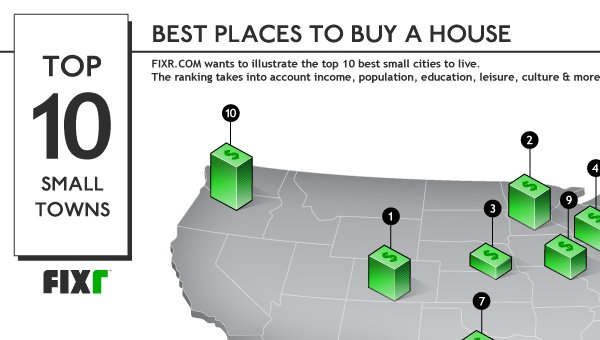What It Shows
This second Fixr infographic shows which small towns in America are the best for buying a home, including a breakdown of various evaluation criteria to help someone make a decision about where to buy a home.
Why It’s Good
I like the general artistic style; the fonts, visuals, and modest coloring work for me.
I also like the three-dimensionality of the graphs in the bottom section, with two axes of relative quantities used. While I have problems with how it turned out as far as relaying information, I think this isometric breakdown worked visually, and I hope I get to see the two-way length-height aspect again.
It’s a nice topic, too.
What It’s Missing
I can see why plenty of culture and leisure options could definitively make for better living, and for buying a home, I think we can probably assume that the lower the property tax the better, but am I meant to assume that the greater the median family income, by definition the better the place to buy a home? I can understand why a very low median income can be worrying, but is the more money better here, straight up?
Under the map of the continental US, there is a 600k median home price figure. I think that’s meant to be a nationwide figure, but I’m not 100% sure. I really don’t like that it points to a specific state, unless it’s meant to be that state’s figures.
For the isometric view graphic at the bottom… I like a lot of it, but I find the way the icons and quantities are represented a bit strange. The visuals are meant to help the communication, but not so much in this case. We are given upper and lower boundaries of quantities for the various criteria, which are then represented on a per-city level with these icons. Instead of having a relative sense between the amount of icons, and guessing how far they are along the horizontal or vertical scales, couldn’t they just go with a simpler 1 given icon = X units, for each criterion? I feel like the details of the information are unnecessarily obscured, and I’m left wondering and having to work out, for example, how many colleges four book icons is meant to represent. 50ish? Some of the criteria aren’t so hard to figure out, but the leisure and culture section would have been so much easier knowing what an icon represents.
The bar graphs are fairly approximate, too, at the bottom and the US map at the top. Yeah, I have a rough idea, but part of me wonders if a simple table with the actual figures would have been an easier way to present and read more detailed information. Maybe some mouseover options exist to give the actual figures.
If the purpose of this infographic was really meant to illustrate why these are the top 10 towns, then some statistics comparing these towns to full US averages or small city averages would be useful. I just don’t feel like enough of a case was made in this infographic alone, and why to live in a place needs many more criteria than those listed here. Aside from my median income gripe, the other choices weren’t bad, but they weren’t enough to definitively demonstrate top tenhood convincingly. Natural scenery, public parks, local festivals and events, quality of local schools, quantity and quality of restaurants… so much factors into where to buy a house, that I think either the scope should have been narrowed to make the amount of data more effective (keeping home-purchase-related finance figures and dropping society and living criteria), or the data should have been widely expanded to attempt to successfully make this admittedly ambitious point.
Also, is there a difference between a small town and a small city? The terms are used interchangeably here, and I don’t think it’s right.
The sourcing is better than the last infographic of theirs that didn’t include any on-infographic sourcing. This one includes sources, but not in any really useful sense. This seems like “get out of trouble” sourcing, rather than “help readers” sourcing. “money.cnn.com” is simply not a sufficient reference. I know people use long URLs sometimes, and it might look weird on the graphic, but you have to put them in full, or provide a single short URL under the heading “Sources for this infographic can be found here:” to a page on your site with all the sources fully listed.
I think the effort was definitely put in, and the designer did some things right, but the quantitative mystery of it all just bothers me too much.
This infographic is fresh from Fixr here.
